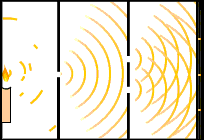Portal:Physics/Selected images/4

In modern physics, the double-slit experiment demonstrates that light and matter can exhibit behavior of either classical particles or classical waves. This ambiguity is considered evidence for the fundamentally probabilistic nature of quantum mechanics. This type of experiment was first performed by Thomas Young in 1801, as a demonstration of the wave behavior of visible light. In 1927, Davisson and Germer and, independently George Paget Thomson and his research student Alexander Reid demonstrated that electrons show the same behavior, which was later extended to atoms and molecules. Thomas Young's experiment with light was part of classical physics long before the development of quantum mechanics and the concept of wave–particle duality. He believed it demonstrated that the Christiaan Huygens' wave theory of light was correct, and his experiment is sometimes referred to as Young's experiment or Young's slits. (Full article...)
